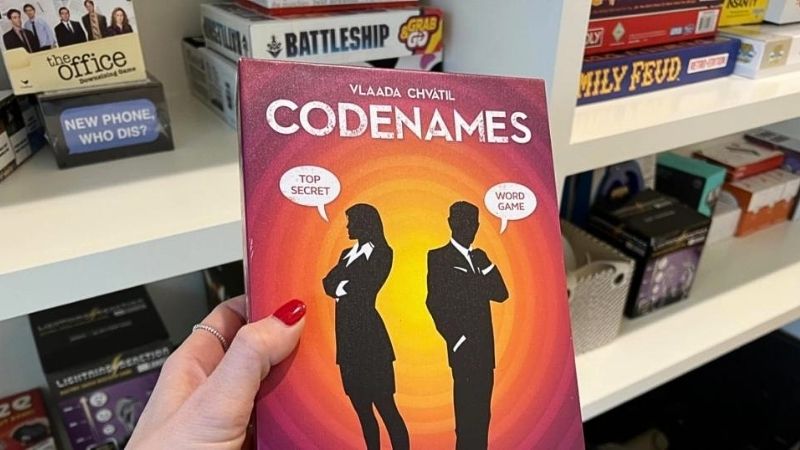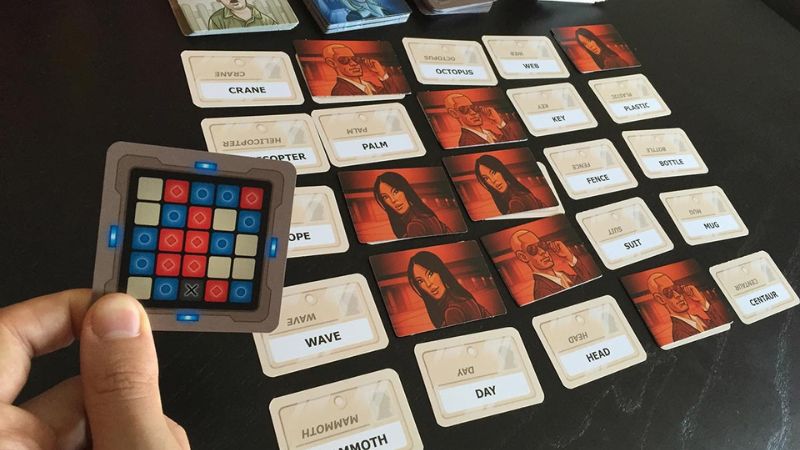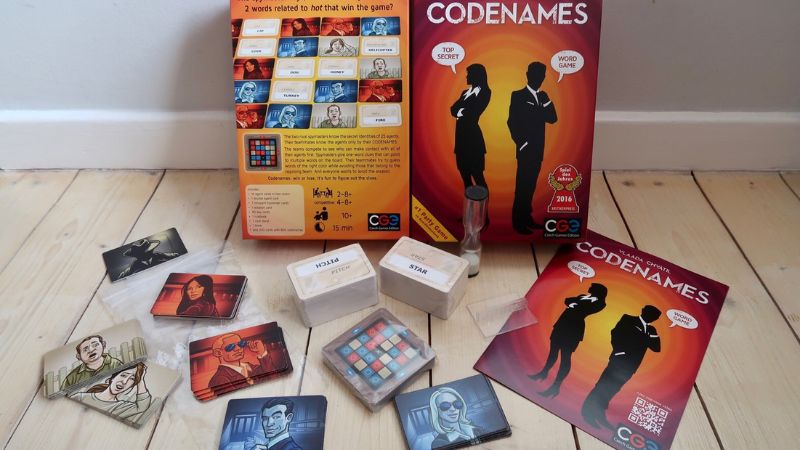If you’re looking for a fun and team-oriented board game to play with friends and family, let’s dive into Codenames, one of the most popular and beloved board games.
1. Introduction to Codenames board game
 Introduction to Codenames board game
Introduction to Codenames board game
For more information: Detailed guide
Codenames is a globally recognized board game that offers a unique detective gameplay experience. It was designed by Vlaada Chvátil and published by Czech Games in 2015.
In 2016, Codenames emerged victorious among numerous contenders to claim the prestigious Spiel des Jahres award, which honors exceptional and enjoyable board games from around the world.
Codenames is designed for 4 to 8 players, divided into 2 teams. This immersive board game creates a world populated by two groups of spies: one in blue and the other in red. Each team is led by a “spymaster” who possesses knowledge of the locations of secret documents concealed by their fellow spies.
The spies on each team follow the instructions provided by their spymaster, working together to identify the designated spies, utter the password, and cautiously retrieve the secret documents.
For more information: Guide
2. Read for 5 minutes to grasp the rules of playing the Codenames board game
 Read for 5 minutes to know the rules of playing Codenames board game
Read for 5 minutes to know the rules of playing Codenames board game
A standard Codenames set includes a map book and stand, a deck of codename cards, 8 green agent cards, 8 red agent cards, 2 double agent cards, 7 civilian cards, and 1 assassin card.
The players are divided into 2 teams with an equal number of members. Each team selects a team leader, and both leaders sit at the head of the table while the other members sit facing one another.
25 codename cards are chosen and randomly arranged in a 5×5 grid. The team leaders privately select a map and position it in a way that prevents other players from viewing it. Each team leader is provided with two sets of agent cards specific to their team.
The agent cards include:
- Agent cards
- Green or red-colored agent cards
- Double agent cards with contrasting colors to the overall theme (e.g., red glasses on a green background) – these belong to the leading team
- Light yellow cards representing civilians, unrelated to the two teams
- A black card representing the assassin
Using the annotations provided on the map, the team leaders must provide instructions to their members, guiding them in identifying the main positions (red for the red team, green for the green team, black for the assassin card, and light yellow squares for civilians).
Each corner of the map features either a green or red square indicating which team will go first and give the initial clue. Furthermore, the team going first must identify 8 positions, as opposed to the usual 7 (depending on the specific cards being used).
For more information: Basic guide for 2 players
3. How to play the Codenames board game
 How to play Codenames board game
How to play Codenames board game
Starting a round
The team leader provides their team members with hints regarding the positions on the board. The team members engage in discussions and work together to identify the positions represented by the illustrations on the game board.
Providing a clue
The team leader gives a clue consisting of a word and the number of cards related to that clue without providing any additional information or answering questions from the other team members. For example, if the team leader intends to refer to the cards labeled NUT and BARK due to their association with trees, they can say “Tree – 2”.
Playing rules require at least 1 accurate clue
Clues can be conveyed through wordplay, homonyms, or spelling. However, mentioning the precise position or shape of the object depicted on the card is prohibited. Additionally, players are not allowed to sing or use facial expressions to communicate with their teammates.
Guessing
Upon receiving the instructions, the team members engage in discussions. If they come to a consensus regarding a clue, they will touch the card corresponding to their selection. The team leader will then examine the map and take one of the following actions:
- If a teammate touches a card that matches a position belonging to their team, the team leader will utilize their team’s agent card to mark that position, allowing the team to make 1 additional guess.
- If the chosen card does not match any positions, the team will forfeit their turn.
- To avoid selecting the position of the assassin card, the team leader should provide clues that have the least connection to the position of the assassin card. Selecting the assassin card results in an immediate loss for the team.
Number of guessing
 Number of guessing
Number of guessing
The teammates must guess at least 1 word. If their guess is correct, they can continue guessing or pass. If their guess is incorrect, they forfeit their turn immediately. On certain occasions, they may be able to guess more than once. For example, if the given clue is “tree – 2” and the related cards are ORANGE and NUT, if a teammate guesses “ORANGE” and it is incorrect, the team will forfeit their turn.
If the team leader provides a clue such as “river – 3” and a teammate chooses the AMAZON square correctly, the team leader will mark it with their agent card, and the teammate can continue guessing.
After correctly guessing 3 positions, the team gets to make one final guess. The team members are allowed to guess the 3rd word of the river or the 2nd word of the tree. Alternatively, they can pass and pass the turn to the opposing team.
Each player is allowed to make a maximum of one additional guess. For example, if the team leader gives a clue as “river – 3”, the remaining members can make a maximum of 4 guesses if the previous 3 consecutive guesses were correct.
Ending the game
The team that discovers all the positions of their codenames emerges victorious, thus ending the game. Alternatively, the opposing team can win during their turn if they identify the final word of the opposing team. The game will end prematurely if a team draws the assassin card.
Next round
After the game concludes, a new team leader is selected for the next round. The agent cards are removed, and 25 new cards are chosen, arranged, and the next round commences.
4. Where to play the Codenames board game online?
 Where to play Codenames board game online?
Where to play Codenames board game online?
To cater to the demand for playing board games anytime and anywhere, numerous publishers have released online versions with gameplay similar to Codenames. Currently, you can play Codenames online via the Codenames website.
5. Tips for playing the Codenames board game
 Tips for playing Codenames board game
Tips for playing Codenames board game
You can employ wordplay to navigate around the rules and make it easier to convey information. However, avoid using excessively difficult words, as they may prove challenging for other players.
Although the board game is designed for groups of 4-8 players, this does not exclude groups of 2 players from participating. If only 2 players are available, both players can be on the same team, with one serving as the spymaster and the other as the operative. Together, they can confront a virtual player.
Above are the rules and gameplay mechanics of the Codenames board game. We hope this article has provided you with a better understanding of this exciting board game.
Exploring Deception and Murder in the Hong Kong Board Game
Do you have what it takes to uncover the truth and apprehend the killer? Put your detective skills to the test in Deception: Murder in Hong Kong, the deduction game of murder mystery and intrigue. Deduce the murderer, the weapon used and the secret evidence from the crime scene. With plenty of plot twists to keep you guessing, can you solve the puzzle and get to the bottom of the case?
A Comprehensive Guide to Playing One Piece: Toonies Boom
Are you ready to take on your competitors in the adrenaline-pumping board game, Toonies Boom? Based on the renowned manga series, One Piece, this exciting game gives players the opportunity to have an explosive battle and have the last laugh. Will you be able to prove that you have what it takes to survive? Play and find out!




































